Are you planning a family road trip to the other side of the Atlantic Ocean but are a little nervous about driving in Europe with your kids?
With quaint towns, breathtaking natural beauty, and rich history, a Europe road trip is a unique experience that you should consider with your family. We personally can’t wait to go back!
However, driving in Europe is a bit different from what we’re used to in Canada or the USA. Europe (and each of the countries within the continent, including Spain) has its distinct set of rules and practices, from road systems to unique traffic signs and regulations.
You want to familiarize yourself with these differences to ensure a smooth and safe trip.
In this blog post, we’ll walk you through the aspects of European driving for North American families, providing you with practical tips and highlighting the key differences to make your road trip as seamless and enjoyable as possible.
Plus, we have the perfect guide and tool to help you feel confident driving in Europe for a fun European road trip with the family.
Disclaimer: Just a heads up, this free article contains affiliate links. If you purchase after clicking one of these links, I may earn a small commission at no additional cost. Also, as an Amazon Associate, I earn from qualifying purchases. Your support helps me continue to provide helpful and free content for you.

Preparing for Driving in Europe: The Perfect Tool
While it might seem daunting at first, preparing for the differences of driving in Europe will remove some of the stress at your destination.
Not only will it ensure your safety and peace of mind, but it also offers the chance to immerse yourself more authentically in the European lifestyle by driving through the roads less traveled.
And we found the perfect tool to help you prepare to drive in Europe (in addition to this guide): Tripiamo International Driving Guide.
Tripiamo offers international driving guides to help you prepare for your road trip. In those detailed county video guides, you’ll know what to expect when driving in a European country.
🚗 🚗 Join Tripiamo, the only platform to help you prepare for driving in Europe.
What is Tripiamo?
Tripiamo provides engaging and informative ways for travelers to learn how to drive confidently abroad by providing online and visual guides. The guides have all the fundamental information needed to be ready to drive in another country.
Tripiamo guides are available for a few European countries, including:
The Tripiamo team is working hard to expand its offerings to more countries in the future. They will be launching the Tripiamo Germany guide shortly.
What Will You Find in a Tripiamo Guide?
Tripiamo Guide materials include:
- Expert tutorial videos: The expert tutorial videos will give you an overview of the different rules when driving in a country. It will inform you about the cultural differences in driving in a specific country.
- PDF country guide: The PDF guides are a useful resource to bring with you when you’re traveling. It will have all the most important road and parking sign in the country and also a few useful words and sentences in the local language.
- 360° driving tours: The best part of the Tripiamo guides is the 360° driving tours. You’ll get to take 360° driving tours through busy European cities, roundabouts and even countryside roads. You’ll also have a detailed list of all the road signs you may see during your road trip.
The guides can be watched at your own pace up to 365 days after your purchase. Most of the documentation is video based to give you a more immersive learning and preparation experience.
Another good thing is that the platformer is compatible with desktop and mobile uses.
Understanding the Rules of the Road When You Drive in Europe
Navigating the European road system can be stressful, especially if you’re planning on driving in a country that has an official language other than English.
Below are the essential aspects of European driving, comparing them to North American norms to help your family road trip go as smoothly as possible.
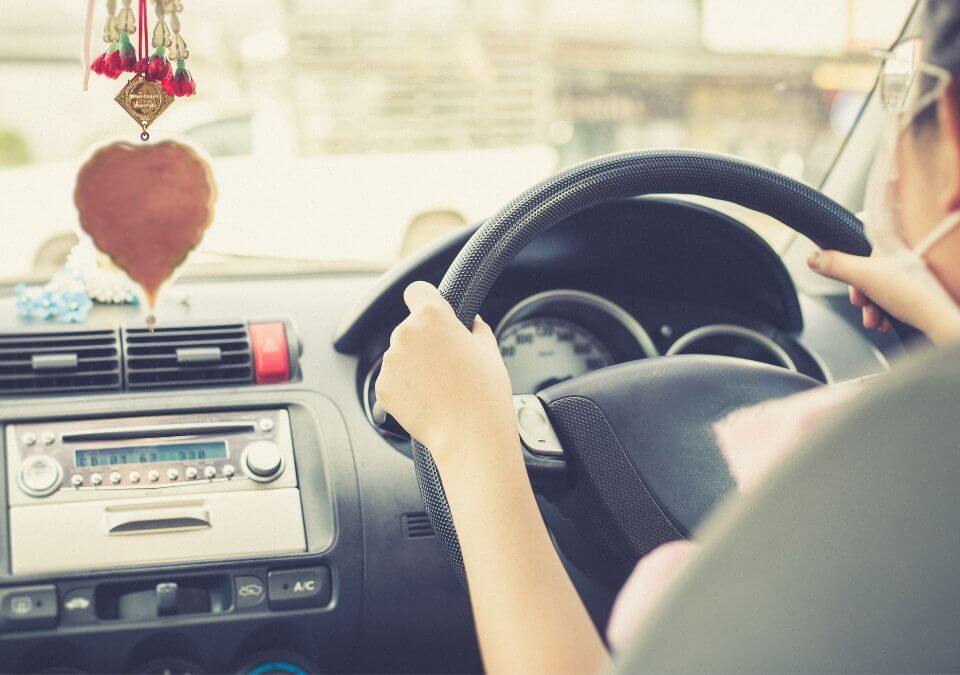
Side of the Road on Which You’ll Drive
Unlike the consistent right-hand driving in North America, the side of the road on which you’ll drive in Europe varies. Most countries drive on the right, with notable exceptions, such as the United Kingdom, Ireland, Malta, and Cyprus, where driving is on the left.
🚗 If you’re planning a family road trip to the United Kingdom, take the time to watch the Tripiamo 360 Driving Tours to better prepare yourself to drive on the other side of the road.
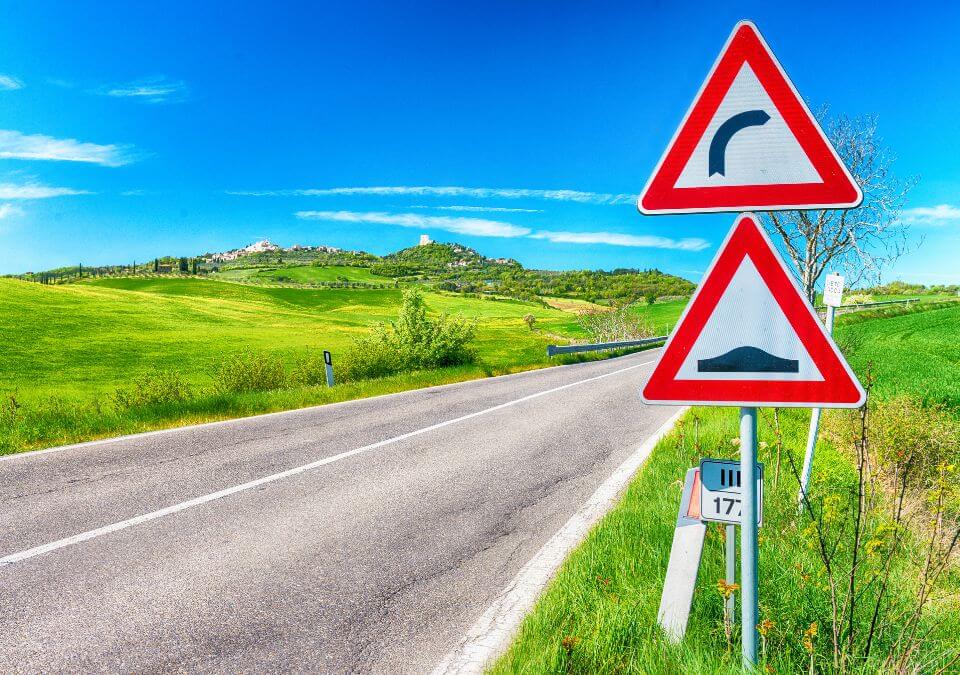
Traffic Signs and Road Markings
Europe’s traffic signs and road markings are more pictorial and less text-based than in North America. Additionally, the shapes and colors of signs in Europe often have different meanings.
For example:
- red circles usually provide prohibitions,
- blue circles indicate mandatory actions, and
- triangles warn of potential hazards.
Ensuring you’re familiar with these signs will enhance your road trip experience by boosting your confidence and safety on European roads.
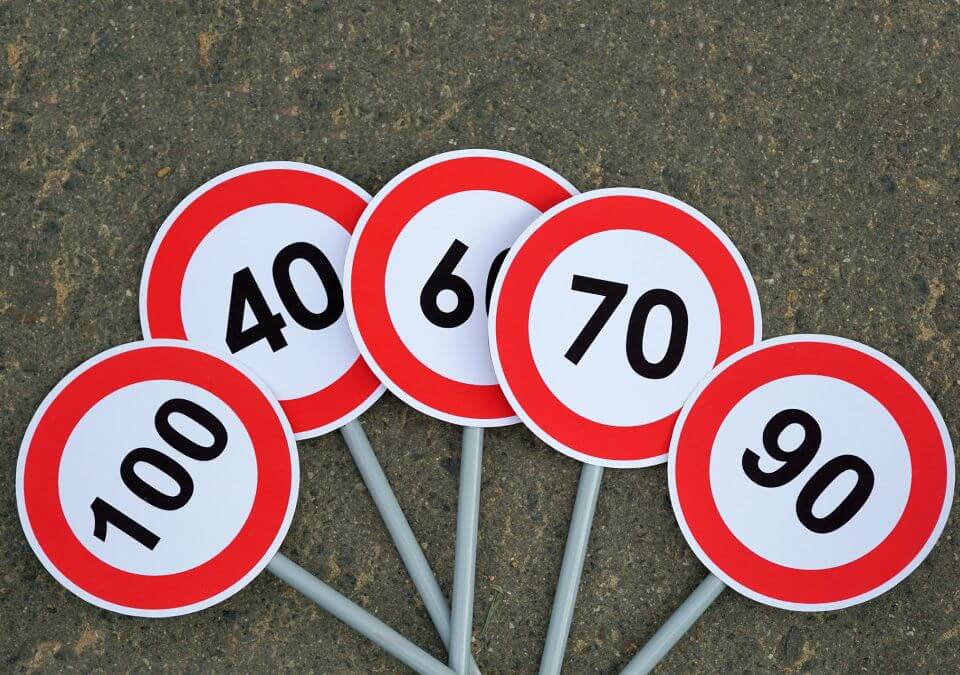
Speed Limits
Unlike the US’s miles per hour, speed limits in Europe are in kilometers per hour.
Typical limits are around:
- 50 km/h in urban areas, with reductions in residential zones
- between 80-100 km/h on rural roads
- 110 km/h to 130 km/h on highways depending on the country.
Germany has portions of autobahns with no official speed limit, a feature quite different from North America’s capped limits.
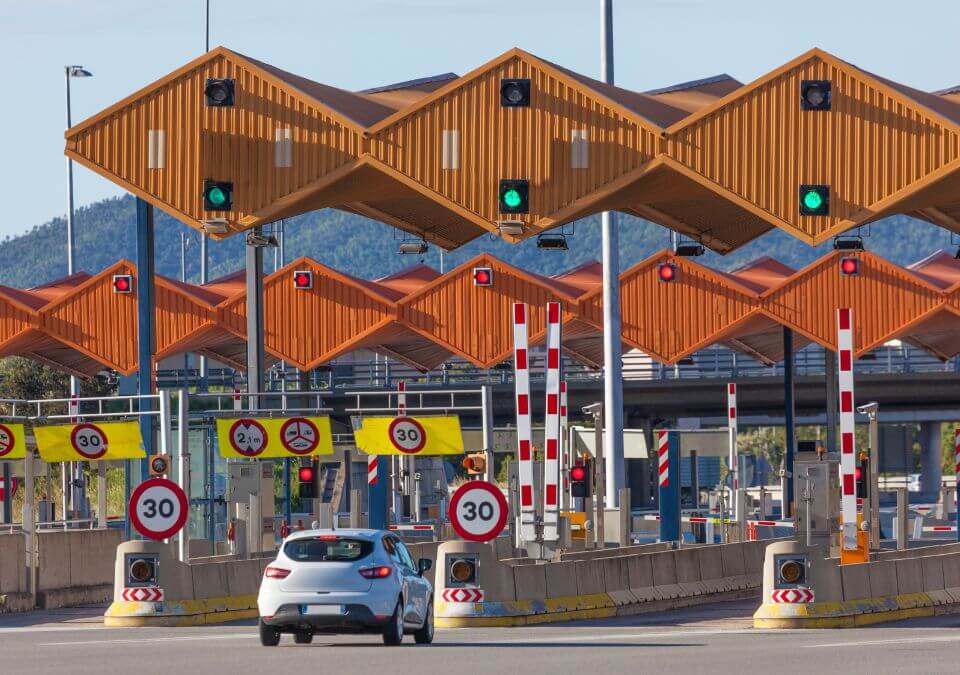
Toll Roads
Europe has an extensive network of toll roads. In general, Europe has many more tolls for the highway systems, and they generally cost more than the US.
There are different payment methods:
- Cash or Card: Many countries accept direct payment at toll booths. Make sure you have some Euros handy, although card payment is often an option too.
- Electronic Tags or Transponders: Some countries, like Portugal, have fully electronic systems without manned booths. Renting a device from your car hire company can be helpful in these cases.
- Pre-paid Tickets: In places like Italy, you get a ticket at the start of a toll road and pay based on the distance traveled when exiting.

Roundabouts
Roundabouts are more common in Europe than in North America. They are everywhere. At first, they can be really intimidating, but after a few hours of driving, you’ll get more comfortable. I really liked watching the 360° driving tours from Tripiamo to get a feel of how it is driving through roundabouts.
In the videos, you’ll learn how to drive through a roundabout safely and what rules to follow. But the best thing is to see the interaction with other cars. It’s not only about the rules and theory of driving in France, but you’ll be “driving” in a real city, going through a real roundabout on a busy day. It’s a great way to get prepared before your trip and to feel more confident once you’re behind the wheel abroad.
Here are a few tips for driving through a roundabout:
- When you approach a roundabout, yield to traffic already in the circle.
- In countries where driving is on the right, always go around the roundabout in a counter-clockwise direction. For countries that drive on the left, navigate clockwise.
- Indicate your exit using your turn signals to inform other drivers of your intended direction.
- Watch the 360° driving tours from Tripiamo to understand better how to drive safely through a roundabout
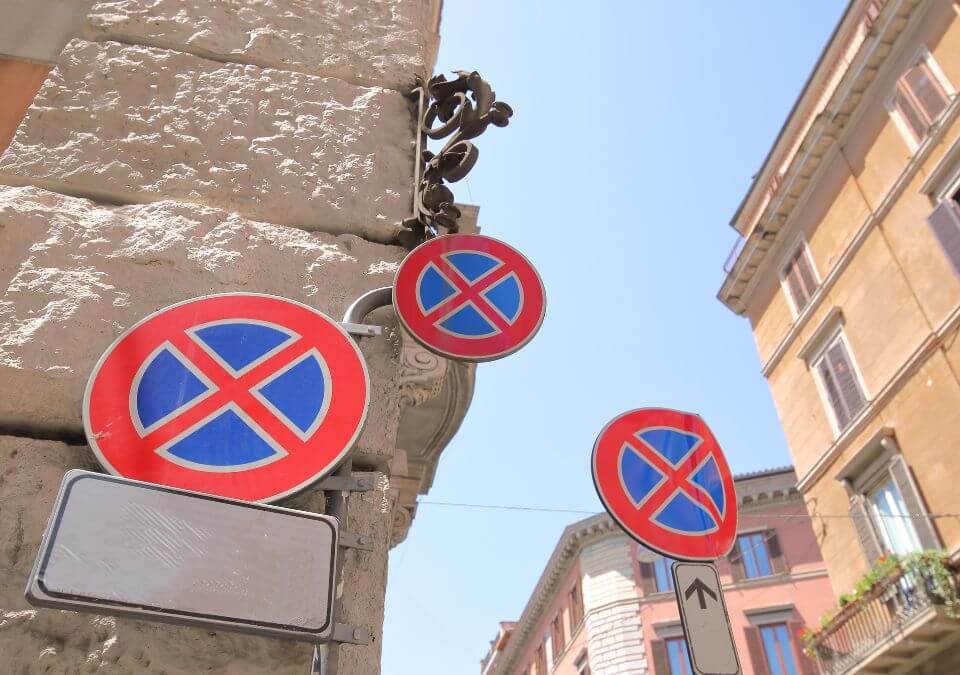
Parking Rules in Europe
European parking rules differ from those in North America. Some key points to remember include:
- Blue Zones: These areas require a parking disc or ‘blue card’ that displays the time you park. You can usually park for free for a limited time.
- White Zones: Typically, you can park for free for an unlimited time.
- Yellow or Red Zones: Parking is usually restricted or reserved for certain vehicles.
For example, a yellow parking zone in Italy is disabled parking.
I’ll always remember my trip to Italy. My friend and I rented a car, and it took us a while to get used to navigating the roundabouts. But parking in Milan and Rome was a disaster. We could not understand the parking signs. It wasn’t the usual red circle with a red slash and a black “P”, like we are used to in Canada.
Every time we had to park, I would get out of the car, take a picture of the sign where we were parked and ask a local person (mostly in signs since my Italian is not up to par) if we could park there or not.
I REALLY wished I had access to Tripiamo to prepare me better to drive in Italy and be more aware of the road sign differences prior to my trip. And I really wished I had an aide-memoire with all the pictograms with me at all times, like Tripiamo’s PDF driving guide. It would have been so helpful and would probably have saved us our parking ticket.
🚗 Make sure we’ve printed your Tripiamo’s PDF driving guide before your trip. It has a lot of information, including the different road signs to watch out for in France, Italy, the UK,…
Restricted Zones
Driving in European cities, particularly older ones, can be challenging due to narrow roads and heavy traffic. Additionally, many cities have restricted zones (like ZTLs in Italy) where only residents or certain authorized vehicles can enter.
Some authorities allocate these zones to reduce traffic and pollution in busy areas, which in turn helps to protect historical buildings. Restricted traffic zones are really common in Italy. Around 350 Italian cities have LTZs, and 250 have low-emission zones. But they do exist in other European countries, such as Spain, Portugal, France and Poland, under different names.
You might what to park outside the city center and use public transportation to avoid restricted zones.
Congestion Charges in Major Cities
Several European cities, like London and Stockholm, have congestion charges. These are fees for driving a vehicle within the chargeable area, aiming to reduce high traffic flow and pollution.
Be aware of these charges and consider whether it’s worth driving into these zones or if public transportation is a more convenient option.

Other Rules
Several other rules may differ from what you’re used to in North America. For instance, rules around the right of way, particularly at non-signaled intersections, can vary. Furthermore, some European cities have congestion charges or low-emission zones that restrict certain vehicles’ entry.
Also, when visiting Europe, you’ll be driving on tiny windy streets. You’ll, at some point, wonder if it’s really a road or if you’re lost. Taking Tripiamo’s video guides will prepare you for that. The video on Spain’s country roads is pretty impressive. You’re “driving” on a two-way country road, but it’s hard to believe it’s an actual road, let alone a two-way road.
Not having watched the videos before and driving on this country road would have stressed me a lot. I would probably have thought it was a one-way or a private road and that I had gotten lost.
Familiarizing yourself with these rules ahead of time can ensure a more seamless driving experience across Europe.
Tripiamo will give you all the information you need to drive in Europe. But it’s so much more than that. It will help you actually get used to driving as if you were already driving in that other country before even stepping foot there. It will definitely take away a lot of fear and stress on your family trip.
🚗 Join Tripiamo, the only platform to help you prepare for driving in Europe.
Driving in Europe with a Car Rental: Tips and Car Requirements
Picking the right rental car and understanding the requirements for driving in Europe are crucial for a successful family road trip. This section provides some guidelines and key insights to help you make informed choices.
Choosing the Right Rental Car
Consider the following factors when selecting a rental car:
- Size: The size of your family and the amount of luggage you’re bringing will determine the car size you need. Remember, European cars, and parking spaces, tend to be smaller.
- Fuel Efficiency: Given the long distances, choosing a fuel-efficient car can save you money. Most cars in Europe are diesel.
- Comfort and Features: Ensure the car has the features you want, such as air conditioning, GPS, or child car seats.
Tripiamo’s guides have great information on what to look for when it’s time to rent your car. Make sure you download Tripiamo’s PDF guide and use their checklist when you’re all the rental company. It will help you when picking up your rental.
Manual vs. Automatic Transmission
In Europe, manual cars are more common and often cheaper to rent. However, if you’re not comfortable driving a manual car, you can find automatic cars, though they may cost more. Be sure to specify your preference when booking.
Thinking of renting a car in Spain? Read this detailed article.
Driving in Europe Requirements: Necessary Documents and Equipment
Europe has specific requirements for what must be in your car:
- International Driving Permit: While not always required, an International Driving Permit (IDP) is recommended. It’s an internationally recognized translation of your driver’s license.
- Reflective Jackets and Other Safety Equipment: Some European countries (including France and Spain) require a reflective jacket in the car, and some also mandate other equipment like a warning triangle or first-aid kit.
Car Insurance Differences
Car insurance is mandatory when renting a car in Europe. Often, your rental will come with basic insurance, but this may have a high deductible.
- Consider getting additional coverage to lower your liability.
- Check if your credit card company provides rental car insurance as part of their service.
Armed with these tips, you’re on the right track to choosing a suitable rental car and driving it confidently across the vast European landscape.
Preparing for Mountain Driving
Driving through Europe’s spectacular mountain ranges, such as the Alps or the Pyrenees, can be one of the most memorable parts of your road trip. However, mountain driving presents unique challenges. Here’s what you need to know.
Challenges of Mountain Driving
Mountain driving in Europe often involves:
- narrow roads,
- sharp turns,
- steep inclines and declines, and
- rapidly changing weather conditions.
Also, unlike most North American mountain roads, many European mountain roads lack guardrails. Thus, careful driving is essential.
Mountain Driving Safety Tips
Here are some safety tips unique to European mountain driving:
- Brakes and Gears: Use lower gears to control speed when going downhill instead of relying on brakes. Brake failure due to overheating is a common problem.
- Passing and Turns: Many mountain roads are single-lane. Use honking as a signal around sharp turns and always be prepared for oncoming traffic.
- Rest Stops: Stop frequently at designated rest points to let your car cool down and enjoy the stunning views!
Snow Chains and Winter Tires
Snow chains and winter tires are often required during winter months on mountain roads:
- Check local requirements before you travel. In some regions, it’s a legal obligation to carry snow chains in the car during winter.
- Ensure your rental car is equipped with winter tires if you’re traveling in the colder months.
By being prepared and understanding the challenges, you can ensure that your family’s journey through Europe’s stunning mountain regions is safe and enjoyable.
Dealing with Emergencies and Breakdowns When You Drive in Europe
Despite all the planning and precautions, emergencies and breakdowns can occur. Here’s an overview of how to handle such situations on your European road trip.
Emergency Numbers Across Europe
The universal European emergency number is 112. It can be dialed free of charge from any phone, including mobiles, anywhere in Europe. It reaches emergency services—police, ambulance, and fire brigade.
You’ll have the European Emergency Number saved in the Tripiamo PDF guides.
Handling Car Breakdowns
In case of a car breakdown:
- safely pull over to the side of the road,
- turn on your hazard lights, and
- set up your warning triangle.
- contact your car rental company or breakdown service. Many rental companies offer 24/7 roadside assistance.
In Europe, unlike most parts of North America, it’s common to wear a reflective jacket when exiting your vehicle after a breakdown. This is a safety measure to ensure other drivers can see you.
The Importance of Travel Insurance
Having comprehensive travel insurance can provide peace of mind during your trip. You’ll want to ensure it covers:
- car rental excess reduction,
- trip cancellation,
- medical emergencies, and
- personal liability.
Check the details of what your insurance covers and ensure it matches your family’s needs and the nature of your road trip. Many credit cards offer good travel insurance coverage that includes car rental insurance.
Being prepared for emergencies and unexpected situations will not only ensure your family’s safety but also reduce stress, allowing you to enjoy your European adventure to the fullest.
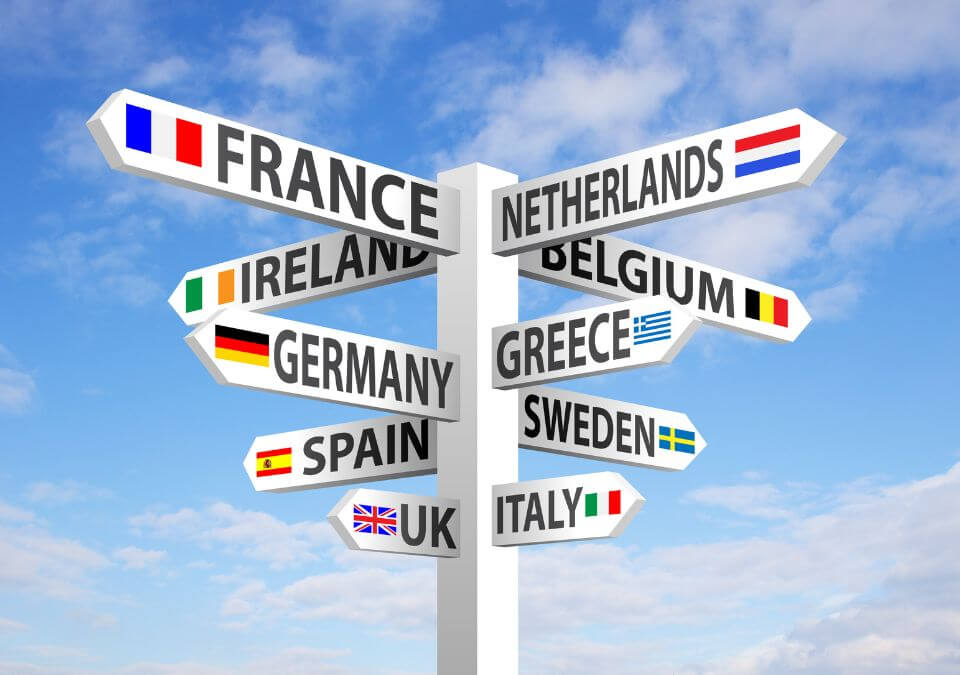
Driving Between Countries in Europe
One of the joys of a European road trip is the opportunity to cross multiple countries. However, it’s important to be aware of varying road rules and border-crossing protocols.
Differences in Road Rules Between European Countries
While there is some uniformity in road rules across Europe, each country has its nuances:
- Speed limits, use of headlights, and rules around child seats can vary between countries.
- Some countries have mandatory equipment requirements, such as breathalyzers in France.
- Toll systems vary significantly across Europe, as discussed earlier.
Be sure to familiarize yourself with the specific rules of each country you plan to drive in.
Border Crossing in the Schengen Area
Crossing borders within the Schengen Area is similar to crossing state lines in the USA or provinces in Canada. Typically, there are no or minimal border checks between countries in the Schengen Area.
However, it’s essential to carry identification (passports for non-EU citizens) as random checks can occur. For non-Schengen countries, border controls remain in place, and visas may be required for certain nationalities.
F.A.Q Driving in Europe
Is it difficult to drive in Europe?
No. Driving in Europe is not necessarily difficult, but it can be different. Factors such as driving on the left side in some countries, dealing with roundabouts, and navigating through dense historical city centers can be challenging initially. However, with preparation, understanding local traffic laws, and getting used to different road signs and markings, you can comfortably adapt.
Do I need anything extra to drive in Europe?
Yes, to drive in Europe, you might need an International Driving Permit alongside your domestic driver’s license. Some countries require carrying specific safety equipment like a reflective jacket, warning triangle, and first-aid kit. Depending on the season and region, winter tires or snow chains may also be necessary.
How easy is it to drive between European countries?
Driving between European countries is relatively easy, especially within the Schengen Area, where border controls are minimal or non-existent. Road signs are generally standardized, and highways are well-maintained. However, keep in mind that driving regulations can vary by country, so familiarize yourself with local rules before you set off.
What is the roundabout rule in Europe?
The general rule for roundabouts in most European countries is that drivers entering the roundabout must yield to traffic already in the roundabout, which comes from their left. This means cars already circulating have the right of way. However, remember that rules may vary slightly by country, so it’s important to familiarize yourself with local regulations.
Can I drive in Europe with a Canadian license?
Yes, you can drive in many European countries with a Canadian driver’s license, but it’s highly recommended also to carry an International Driving Permit (IDP). An IDP is a translation of your driver’s license and is recognized internationally. Some rental companies or authorities may require it, and it’s particularly useful in case of a traffic stop or accident.
Can I drive in Europe with a US license?
Yes, you can drive in many European countries with a U.S. driver’s license, but it’s generally recommended also to carry an International Driving Permit (IDP). The IDP, which translates your license details into multiple languages, can be particularly useful in situations like car rental or traffic stops. However, the requirements can vary by country, so it’s best to check the specific regulations for each country you plan to visit.
Can you turn right at a red light in Europe?
Unlike in many parts of the U.S. and Canada, turning right on a red light is generally not allowed in most European countries unless there’s a specific sign indicating that it is permissible. Always make sure to familiarize yourself with the local traffic rules before driving in a foreign country.
What is the most difficult European country to drive?
The difficulty of driving can vary greatly depending on the individual driver’s skills and comfort levels. However, some travelers might find countries like Italy or Greece more challenging due to their hilly terrain, narrow roads, dense traffic in cities, and local driving culture. Additionally, if you’re unaccustomed to driving on the left side of the road, countries such as the United Kingdom and Ireland could be tricky initially.
Final Thoughts: Driving in Europe as an American and Canadian
Preparation is key to feeling comfortable driving a car in Europe. Tripiamo is a great tool and resource to purchase when planning your road trip to Europe.
Remember to stay flexible, stay safe, and soak in the diversity and beauty Europe offers. Plan well, but also leave some room for spontaneity and detours – some of the best memories are made when the unexpected is embraced. Enjoy the open roads, the freedom, the quaint villages, the historic cities, and the myriad of experiences that a European road trip brings. Here’s to your epic road trip and the unforgettable memories you’ll no doubt create. Safe travels!

